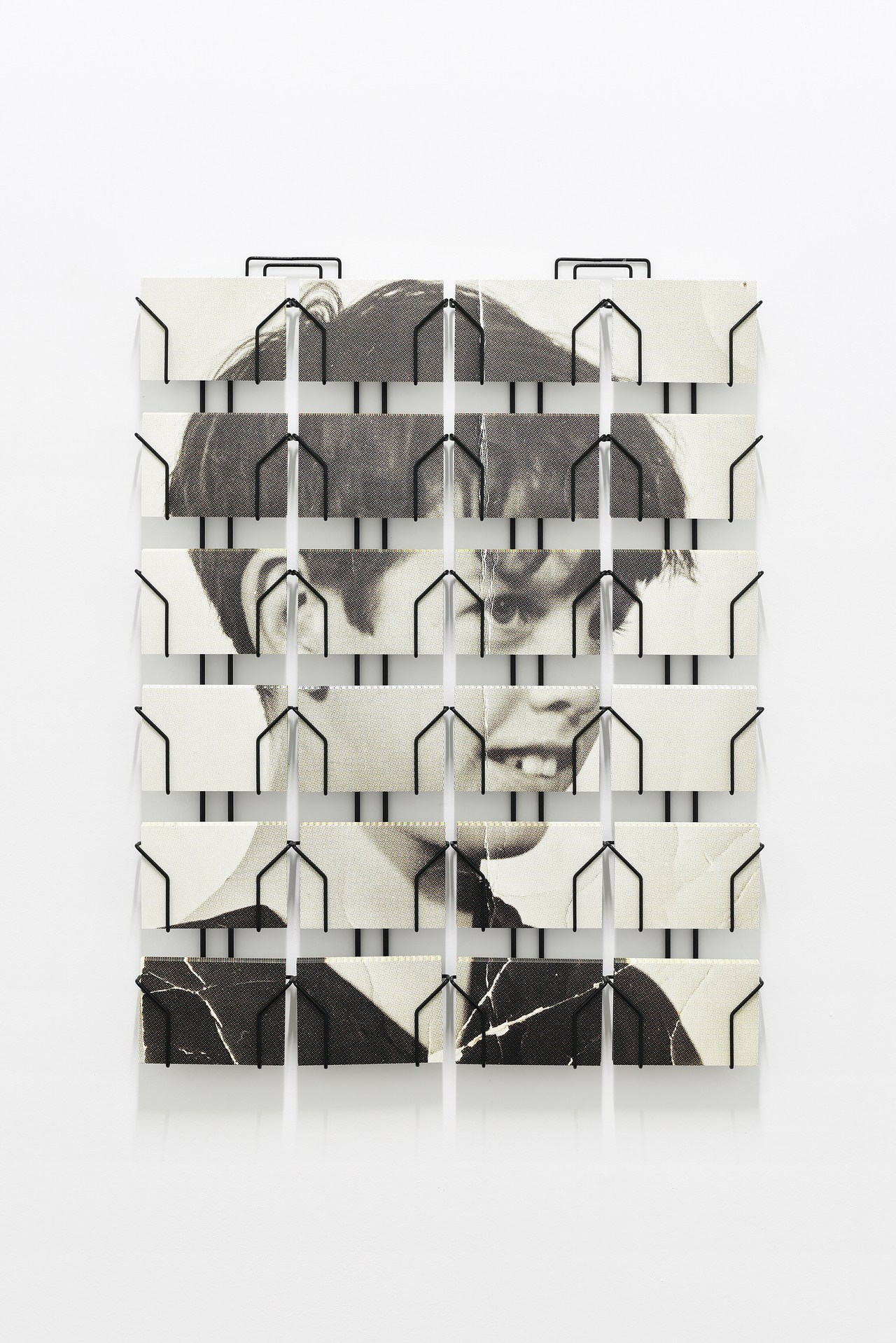
© » KADIST
Doreen Lynette Garner
Known But to God: The Dug Up, Dissected, and Disposed for the Sake of Medicine by Doreen Lynnette Garner is a small, suspended sculpture composed of glass, silicone, steel, epoxy putty, pearls, Swarovski crystals, and whiskey. At once attractive and repulsive, the sculpture combines objects of adornment with what appears to be viscera. The sculpture’s curious delicacy evokes a ritualistic catharsis, in response to persistent forms of medical racial violence and objectification for Black people in America and around the world.

© » KADIST
Annette Kelm
In Stilleben mid Zierlauch ( Still Life with Aluminum) Annette Kelm utilizes visual juxtaposition to bring together a gridded aluminum backdrop, a pot with a vaguely indigenous pattern on it, and two purple dandelions. The aesthetic dissonance between the mechanical, gridded aluminum and the grainy clay pot signify an interaction between systems of visual production, furthered by the aluminum grid’s inward tilt, visually apparent due to the grid pattern’s convergence at the top of the photograph. Contrasting the stark slant of the grid, the pot sits on a level surface, while the two tall stems protruding from it run at a non-parallel angle to the grid.

© » KADIST
Joscelyn Gardner
Drawing & Print (Drawing & Print)
Creole Portraits III alludes to the 18th century practice by slave women on Caribbean plantations of using tropical plants as natural abortifacients. As an act of political resistance against their exploitation as “breeders” of new slaves and to protest the inhumanity of slavery, some slave women chose to either abort or kill their offspring. Armed with practical knowledge passed on orally from their African ancestors and/or Amerindian counterparts, enslaved Creole women collected the seeds, bark, flowers, sap, and roots from various plants which allowed them to secretly put an end to their pregnancies.

© » KADIST
Harm van den Dorpel
Indiscreet Units by Harm van den Dorpel is a group of more than 266 hue-rotating flags, stored on the Ethereum blockchain and IPFS. This is a project about the indeterminacy of color, and that variability as a metaphor for larger social and political forces. Each NFT in the series is the official flag design for nations (and related entities) around the world.
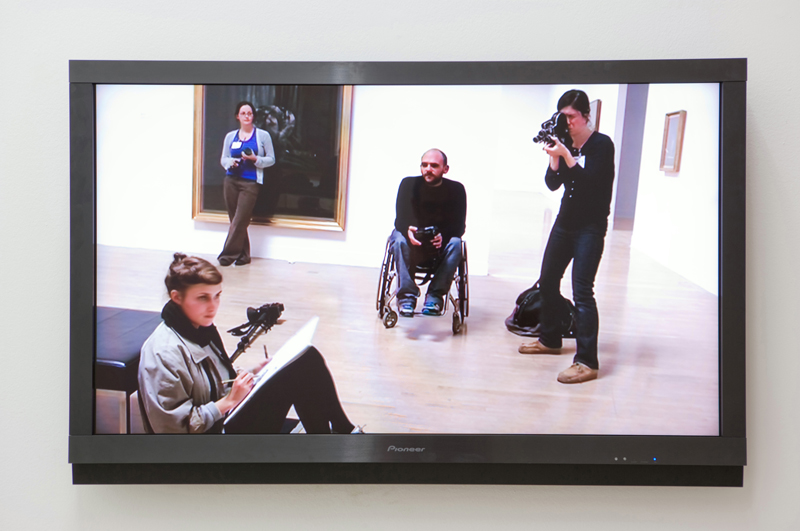
© » KADIST
Ryan Gander
The work consists of a work inside a work. The spectator is presented with a commissioned documentary on a flat-screen Tv on the subject of the production of the making of an artwork that doesn’t exist entitled The magic and the meaning (2008). The imaginary film, The magic and the meaning , is described only within the documentary, which follows parts of the making of the film, extracts from interviews with the writer and film maker Dan Fox and the artist and maker of the work Ryan Gander; as well as showing short slow-motion sections of the film that does not exist.
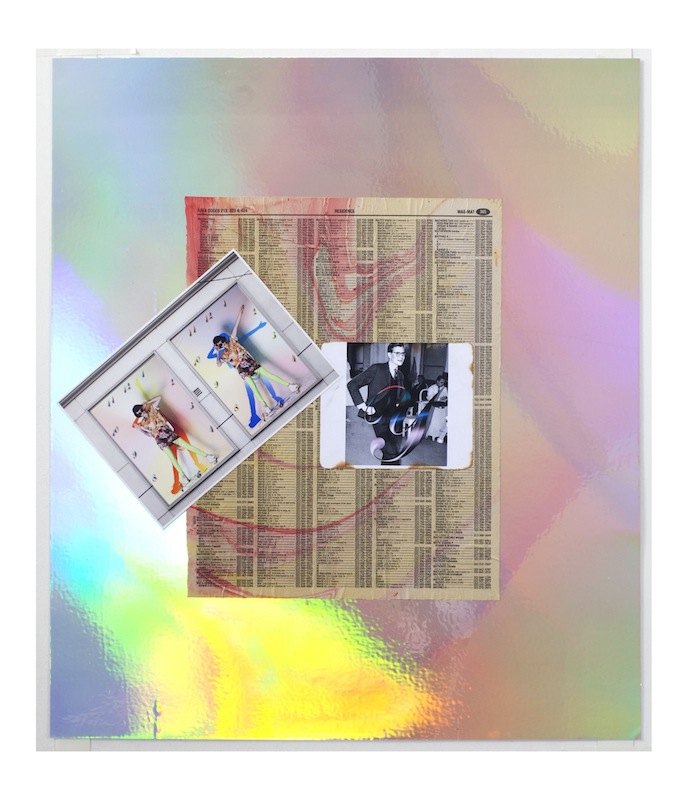
© » KADIST
Carter Mull
Mull’s Worker’s Clock collage works bring together images from the artist’s studio photography practice, found photographs, and pages from a phone book, laying them over a psychedelic warp of color in the background. One of the images is borrowed from a billboard, Double Block (for Alanna Pearl, Nik Nova and R. Mutt) (2013) that Mull created to hang above some storefronts in downtown Los Angeles. The pair of photographs features a woman posed in the center for rings of numbers, her body and shadow taking the place of the mechanical hands.
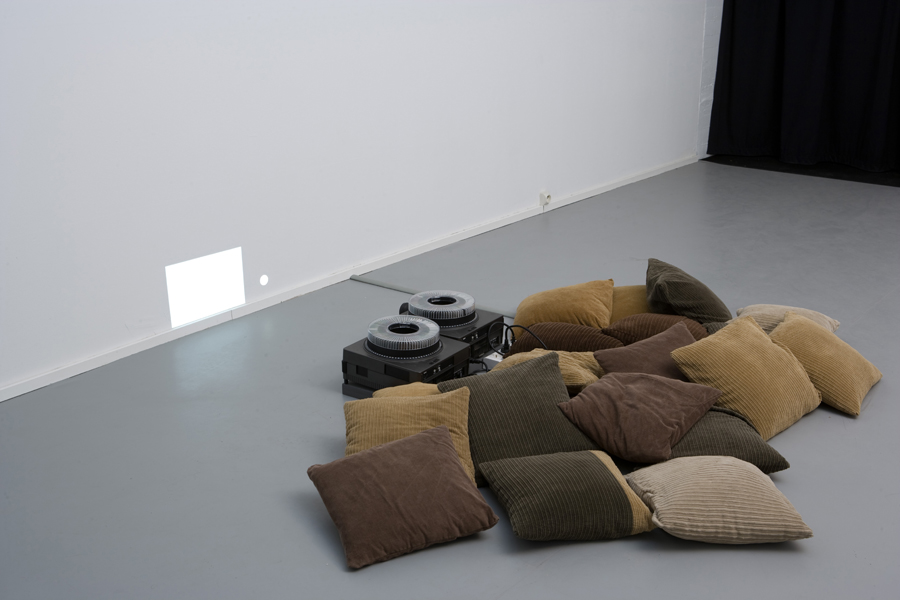
© » KADIST
Ryan Gander
This work is meditative and fragile. These abstract forms are projected slides belonging to another lecture, Travelogue , where the images have been removed. What is left is the hole of the frame of the slide that light draws upon and projects on the wall.
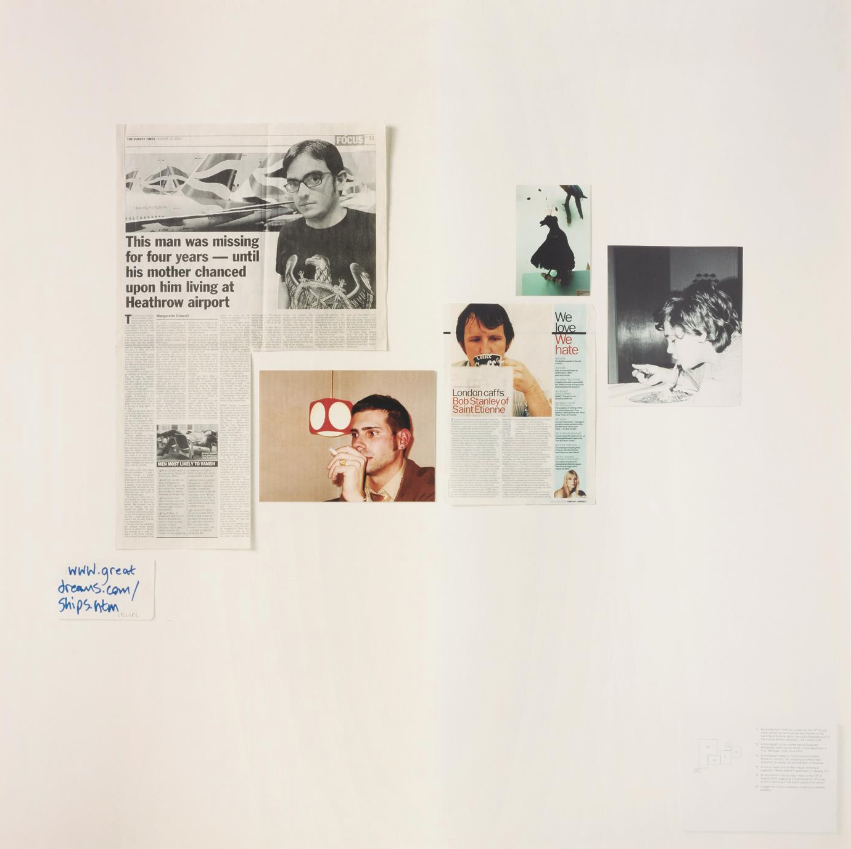
© » KADIST
Ryan Gander
Ryan Gander is a collector. He keeps all sorts of documents to create from. His studio is full of found images, personal images, documents copied from internet or cutout of newspapers.

© » KADIST
Carter Mull
Mull’s Worker’s Clock collage works bring together images from the artist’s studio photography practice, found photographs, and pages from a phone book, laying them over a psychedelic warp of color in the background. One of the images is borrowed from a billboard, Double Block (for Alanna Pearl, Nik Nova and R. Mutt) (2013) that Mull created to hang above some storefronts in downtown Los Angeles. The pair of photographs features a woman posed in the center for rings of numbers, her body and shadow taking the place of the mechanical hands.

© » KADIST
Ryan Gander
A vehicle without light is a group of more personal photographs. This includes an image of a pirate radio in the 1960s, a story from the BBC website and the photo of Mary Aurore. Mary Aurore, is in fact a character he invented whose identity is impossible to determine but who appears in various works.

© » KADIST
Annette Kelm
Drawing & Print (Drawing & Print)
Percent for Art is seemingly concerned with “art enrichment” by state or city arts agencies role in it, managing the artist rosters, maintaining public art collections, commissioning artworks, selecting installation sites, among other things for aesthetic and cultural enhancement in both public and private real estate developments. For some, it’s also an opportunity to have desperately needed revenue to counter the displacement of artists and preserve a city or state’s creative spirit. The work, with its serial repetition of percentage signs across six separate bright red panels, appears as splashy retail signage for no apparent sale.

© » KADIST
Werner Herzog
Commissioned for the 2012 Whitney Biennial, Hearsay of the Soul (2012) is Werner Herzog’s ode to the landscape paintings of the 17th-century Dutch artist Hercules Segers. The work is a four-channel digital projection of Segers’s artworks accompanied by the emotive music of the Dutch cellist and composer Ernst Reijseger. Herzog sees Segers’s vast landscapes as powerful representations of our own interior worlds, resounding with feelings of anger, joy, fear, and loneliness.

© » KADIST
Charles Gaines
To make his series Shadows (1980), Gaines subjected 20 potted plants to a uniform procedure. Each is pictured four times: a photograph of the plant, a photograph of its shadow, a drawing of the plant, and a drawing of its shadow. Instead of lending structure to disparate entities, this system serves a counterintuitive purpose, dissolving the object.

© » KADIST
Ryan Gander
Epiphany…learnt through hardship is composed of a bronze sculpture depicting the model of the little dancer of Degas, in the pose of a female nude photographed by Edward Weston (Nude, 1936) accompanied by a blue cube. The work refers to the positive occupations of space and the absence of form and structure, to the relationship between the visible and the invisible, to memory, and to the relationship we have to images and to our history. The work refers to childhood, biography and learning to question how meaning is made and how history is remembered and performed.
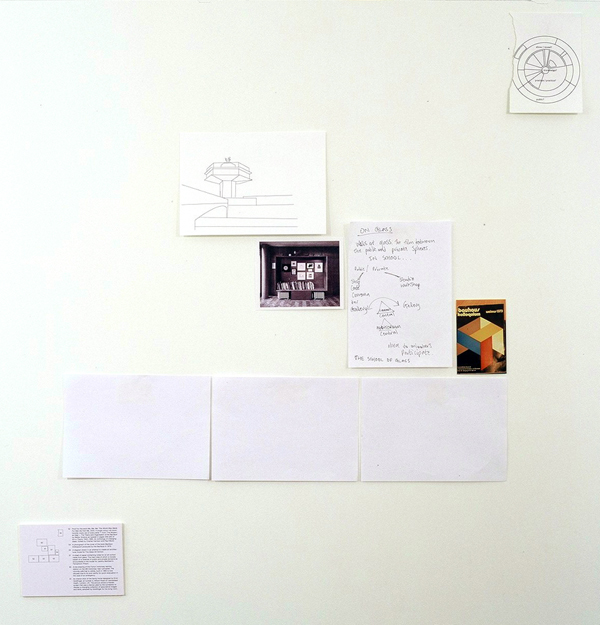
© » KADIST
Ryan Gander
You see without light is a group of photographs around the theme of Bauhaus. This includes a reference to one of Gander’s works which is the Bauhaus manifesto without dots on the letter ‘i’, as well as drawings of his ideal art school.

© » KADIST
Geoffrey Farmer
Ongoing Time Stabbed with a Dagger was Farmer’s first kinetic sculpture that added a cinematic character to an “ever-reconfiguring play presented in real time.” The assembly of various objects and props on top of a large platform constitutes not only a work, but, to a certain extent, a show in itself. The title of the piece comes from the literal translation of René Magritte’s painting from 1938, La Durée Poignardée , whose more familiar translation is “Time Transfixed.”

© » KADIST
Harm van den Dorpel
Advanced Technology (Advanced Technology)
Mutant Garden Autobreeder by Harm van den Dorpel is a generative animated artwork based on evolutionary programming that never appears the same twice. The work is based on an existing algorithm called Cartesian Genetic Programming, invented by Julian F. Miller and Peter Thomson in 1997, the system itself having been finely tuned by van den Dorpel to produce a very particular quality of qualia. The software has been carefully constructed to produce a stream of new and unpredictable mutations that build and react to each previous generation of image.

© » KADIST
Oren Pinhassi
Oren Pinhassi’s work examines the relationship between the human figure and the built environment. His hybrid sculptures, often somewhat emaciated, hover between the figurative and the architectural. In the case of The Crowd , a series of sculptures which evince architectures of control – where humans act and exert power – we find voting booths, segregation cells, institutional desks, places where bureaucratic exchange become spaces of bodily desire, complete with sexual appendages.
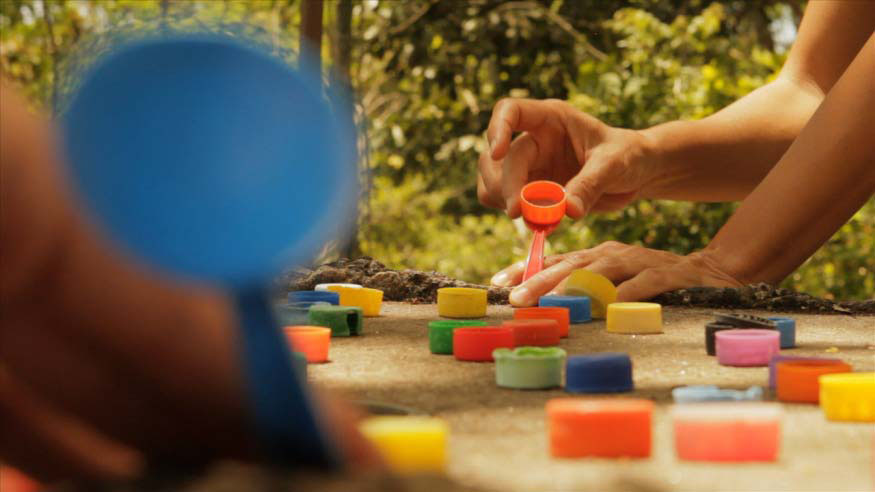
© » KADIST
Donna Conlon and Jonathan Harker
In Tapitapultas (2012), Donna Conlon and Jonathan Harker comment on mass consumerism and pollution by way of a game they invented. The artists used disposable spoons as catapults to shoot thousands of plastic bottle caps at a hole in a concrete platform. The platform was once part of a U. S. military installation in the Panama Canal Zone, and it is now an observation deck in a nature park.

© » KADIST
Bárbara Wagner & Benjamin de Burca
Originally commissioned for the 32nd Sao Paulo Biennial, the film Estás vendo coisas (You are seeing things) depicts the subculture of Brega music, a fusion of American Hip Hop, Brazilian techno and Caribbean reggaeton that emerged in North Eastern Brazil over the last decade. Part anthropological documentary and part musical the film speaks about the realities of Brazil with its enormous social and economic tensions.
Ryan Gander
- location: Chester, United Kingdom
- year born: 1976
- gender: male
- nationality: British
Harm van den Dorpel
Harm van den Dorpel’s practice focuses on emergent systems and the role technology plays in their development and meaning...
Carter Mull
Los Angeles-based artist Carter Mull is an obsessive sort, and his fascinations show through in his multimedia photographic and installation-based works...
Annette Kelm
- location: Stuttgart, Deutschland
- year born: 1975
- gender: female
- nationality: German
Donna Conlon and Jonathan Harker
- location: Panama City, Panama
- year born: 1966
- nationality: American and Ecuadorian
Charles Gaines
- location: Los Angeles, California
- year born: 1944
- gender: male
- nationality: American
- home town: Charleston, South Carolina
Werner Herzog
Werner Herzog is a renowned filmmaker, screenwriter, actor, and producer; he makes both documentaries and fictional films that aim to reveal what he calls ecstatic truths about humanity...
Oren Pinhassi
Oren Pinhass’s practice integrates architecture and sculpture in the making of fantastical forms, employing found objects as well as replicating such objects in various media...
Joscelyn Gardner
Joscelyn Gardner is a Caribbean / Canadian visual artist working primarily with printmaking and multimedia installation...
Doreen Lynette Garner
Doreen Lynette Garner’s practice examines the histories and enduring effects of racial violence in the United States...
Geoffrey Farmer
- location: Vancouver, British Columbia
- year born: 1967
- gender: male
- nationality: Canadian
- home town: Eagle Island, Canada
-
1980-1989
Charles Gaines
1980To make his series Shadows (1980), Gaines subjected 20 potted plants to a uniform procedure...
-
2000-2009
Joscelyn Gardner
Drawing & Print
2009(Drawing & Print) Creole Portraits III alludes to the 18th century practice by slave women on Caribbean plantations of using tropical plants as natural abortifacients...
Geoffrey Farmer
2009Ongoing Time Stabbed with a Dagger was Farmer’s first kinetic sculpture that added a cinematic character to an “ever-reconfiguring play presented in real time.” The assembly of various objects and props on top of a large platform constitutes not only a work, but, to a certain extent, a show in itself...
-
2010-2019
Werner Herzog
2012Commissioned for the 2012 Whitney Biennial, Hearsay of the Soul (2012) is Werner Herzog’s ode to the landscape paintings of the 17th-century Dutch artist Hercules Segers...
Ryan Gander
2012Epiphany…learnt through hardship is composed of a bronze sculpture depicting the model of the little dancer of Degas, in the pose of a female nude photographed by Edward Weston (Nude, 1936) accompanied by a blue cube...
Donna Conlon and Jonathan Harker
2012In Tapitapultas (2012), Donna Conlon and Jonathan Harker comment on mass consumerism and pollution by way of a game they invented...
Carter Mull
2013Mull’s Worker’s Clock collage works bring together images from the artist’s studio photography practice, found photographs, and pages from a phone book, laying them over a psychedelic warp of color in the background...
Carter Mull
2013Mull’s Worker’s Clock collage works bring together images from the artist’s studio photography practice, found photographs, and pages from a phone book, laying them over a psychedelic warp of color in the background...
Annette Kelm
Drawing & Print
2013(Drawing & Print) Percent for Art is seemingly concerned with “art enrichment” by state or city arts agencies role in it, managing the artist rosters, maintaining public art collections, commissioning artworks, selecting installation sites, among other things for aesthetic and cultural enhancement in both public and private real estate developments...
Annette Kelm
2014In Stilleben mid Zierlauch ( Still Life with Aluminum) Annette Kelm utilizes visual juxtaposition to bring together a gridded aluminum backdrop, a pot with a vaguely indigenous pattern on it, and two purple dandelions...
Bárbara Wagner & Benjamin de Burca
2016Originally commissioned for the 32nd Sao Paulo Biennial, the film Estás vendo coisas (You are seeing things) depicts the subculture of Brega music, a fusion of American Hip Hop, Brazilian techno and Caribbean reggaeton that emerged in North Eastern Brazil over the last decade...
Doreen Lynette Garner
2017Known But to God: The Dug Up, Dissected, and Disposed for the Sake of Medicine by Doreen Lynnette Garner is a small, suspended sculpture composed of glass, silicone, steel, epoxy putty, pearls, Swarovski crystals, and whiskey...
-
2020-2029
Oren Pinhassi
2020Oren Pinhassi’s work examines the relationship between the human figure and the built environment...
Harm van den Dorpel
Advanced Technology
2021(Advanced Technology) Mutant Garden Autobreeder by Harm van den Dorpel is a generative animated artwork based on evolutionary programming that never appears the same twice...
Harm van den Dorpel
2022Indiscreet Units by Harm van den Dorpel is a group of more than 266 hue-rotating flags, stored on the Ethereum blockchain and IPFS...
